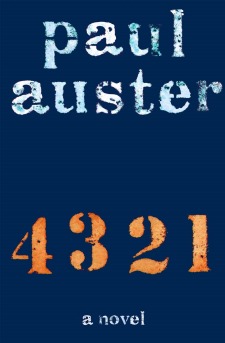
4 3 2 1
I’ve been a fan of Paul Auster’s since I picked up a copy of his 2004 novel, The Brooklyn Follies, while perusing the shelves of Bookstar, the long-gone bookseller in Poplar Plaza. In the years since, I’ve delighted in finding Auster’s books by making my way down the “A” shelf until I, hopefully, found something I’d never read. And many of them — Oracle Night, The Red Notebook, The Music of Chance — have been found this way.
His last novel, Sunset Park, was published in 2010. It’s been a long time since I had a new bit of Auster, so I was excited by this month’s release of 4 3 2 1: A Novel. So excited, in fact, that I contacted Henry Holt and Company for an advance reader’s copy. What arrived in the mail is a soft-back brick, clocking in at nearly 900 pages. By far, it’s Auster’s largest offering, larger even than The New York Trilogy, which is actually three stories in one, yet is a third of the size of his new one.
This novel, though, is four novels in one, really, and the clever structure of it takes some getting used to but is well worth the effort. Archibald Isaac Ferguson is born in 1947, and we follow his life as he ages. It’s a typical boy’s life with days filled by baseball, friendship, school, bullies, summer camp, and the first whisperings of sex. But it’s not such a simple coming-of-age story as this — young Ferguson splits off into four separate Fergusons, and each one leads a life different from the others. Chapters are laid out as 1.1, 1.2, 1.3, 1.4, and on to 2.1, 2.2, etc. In one stepping-stone “life,” Ferguson’s father’s appliance store burns to the ground, causing his story to take a different turn from the Ferguson whose father’s store swells with success and the consequent wealth.
4 3 2 1 illustrates that some paths are chosen for us while others present themselves due to choices we make. I’ve always made a point of choosing to shop in bookstores, but I will admit that I’m just as apt to click a button and have a book delivered to my porch as anyone. It’s a simple choice, really, but a salient one as we watch the Booksellers at Laurelwood prepare to join Bookstar (and Borders and Mid-America Books and Pinocchio’s) as mere memory.
The locals hold a special place in my heart. I worked at Bookstar as a second job in the months leading up to my wedding in 1994. Years later, as young parents with a toddler, we found moments of calm in the children’s section of Booksellers (then Davis-Kidd) as our son explored and we read. Burke’s Book Store hosted a reading and signing for me when my novel was published in 2015. These are memories that will last a lifetime and places I’d hoped to take my own children and, eventually, grandchildren. I need them to stick around. We all do. Bookstores are gathering places, communal think-tanks where young parents become reenergized and their children can become familiar with the world and their community all in one place.
Auster’s own bookstore of choice is the independent Community Bookstore in Park Slope, Brooklyn, and he told Travel & Leisure magazine, “The shop is a crucial part of my neighborhood.” And in The Brooklyn Follies, he writes of fictional bookstore Brightman’s Attic: “Thousands of items were crammed onto the shelves down there — everything from out-of-print dictionaries to forgotten bestsellers to leatherbound sets of Shakespeare — and Tom had always felt at home in that kind of paper mausoleum, flipping through piles of discarded books and breathing in the old dusty smells.”
